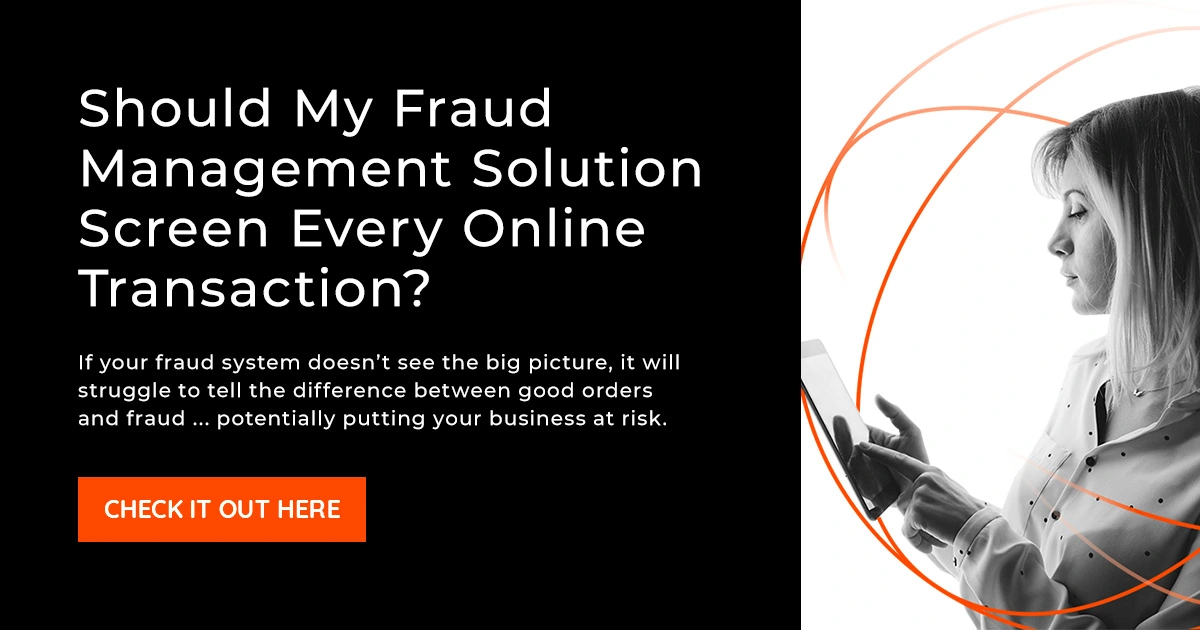Why Low Marginal Costs Don’t Eliminate the Risk from Chargebacks
A common claim among ecommerce businesses is that their high chargeback rates are offset by low marginal costs. They trick themselves into believing their bottom line will ultimately benefit. But, left unchecked, high chargeback rates become quite costly and can threaten your ability to conduct online business.
To illustrate how high chargeback rates can work against you, let’s look at the fundamentals.
What Is a Chargeback?
Let’s say a credit card holder questions a transaction and files a complaint with the issuer. If the issuer refunds the purchase amount back to the cardholder, it reverses the payment made to the business. It will also add a fee of anywhere from $20, for processors like PayPal, up to $100. This payment reversal and fee paid by the business is called a chargeback.
What Are the Reasons for Issuing a Chargeback?
In some cases, chargebacks are issued because of potentially valid problems with the transaction:
- The customer pays for an order but claims they never received it.
- The customer makes a return and claims the credit did not post to their account.
- The customer cancels a recurring transaction (or forgets about it) and claims it shouldn’t be charged to their account.
- Any number of technical problems, from double charging to authorization errors.
The majority of chargebacks are issued due to fraud:
- Someone uses a customer’s debit/credit card illegally.
- A customer orders from the business, receives the goods and then makes a false claim about not receiving it. This is called friendly fraud.
Regardless of the reason, chargebacks are costly and inconvenient. Aside from the fee per transaction and lost shipment expenses, businesses spend time and money disputing chargeback claims. Once chargeback rates become too high, there are even more fees.
“Payment processors do not like dealing with a large number of chargebacks,” says Bruno Farinelli, Senior Director of Risk and Customer Success for ClearSale. “A business that is struggling to control their chargeback rate could find themselves in a chargeback monitoring program.”
What Is a Chargeback Monitoring Program, and How Does It Work?
Payment processors measure chargeback rates by tracking raw numbers and what’s called a chargeback ratio — the number of chargebacks in a single month divided by the total number of transactions in the same month. Processors set limits, or thresholds, that determine how they will respond to high chargeback rates, including chargeback monitoring programs with high fees and consequences.
How Visa monitors chargebacks
Visa has a monitoring program with an early warning system to identify businesses with an excessively high number of chargeback disputes. The Visa Dispute Monitoring Program (VDMP) reviews a previous month’s processing activity and identifies businesses that exceed the program thresholds.
Visa officially has two levels of threshold, standard and high risk/excessive, which are determined by the ratio of chargebacks to total transactions calculated at the end of each month. It also has a lower early warning threshold to alert merchants if they’re in danger of entering the program. Here are the thresholds:
- Early Warning: a dispute ratio of 0.65% and a minimum of 75 chargebacks
- Standard: a dispute ratio of 0.9% and a minimum of 100 chargebacks
- Excessive: a dispute ratio of 1.8% and a minimum of 1,000 chargebacks
A notification of Early Warning is the business’s chance to implement a chargeback management strategy. If the business’s rate increases to the Standard level, it will be placed in Visa’s Dispute Monitoring Program. Businesses then have four months to reduce their chargeback rate before a hefty fee structure kicks in (see chart).
|
Months 1-4 |
Workout period |
|
Months 5-9 |
Visa fine of 50 USD/45 EUR per dispute |
|
Months 10-11 |
Visa fine of 50 USD/45 EUR per dispute 25,000 USD review fee (non-EU businesses only) May require audit |
|
Months 12+ |
Visa fine of 50 USD / 45 EUR per dispute 25,000 USD review fee May require audit Business eligible for disqualification (i.e., can no longer process Visa payments) |
While the widely accepted chargeback rate threshold is 1%, Visa reduced theirs to 0.9% in 2019. Other processors may follow suit.
The fees get faster and more furious once a business’s chargeback ratio hits 1.8% or 1,000 per month. This qualifies for Visa’s Excessive level of disputes, and fees accrue much more quickly for these businesses.
|
Months 1-6 |
Visa fine of 50 USD/45 EUR per dispute |
|
Months 7-11 |
Visa fine of 50 USD/45 EUR per dispute 25,000 USD review fee (non-EU businesses only) May require audit |
|
Months 12+ |
Visa fine of 50 USD/45 EUR per dispute 25,000 USD review fee May require audit Business eligible for disqualification (i.e., can no longer process Visa payments) |
How Do Businesses Get Out of Chargeback Monitoring Programs?
To be removed from a monitoring program, businesses must consistently maintain a low chargeback rate.
With Visa’s program, that means staying below 0.9% for three consecutive months. But they’re not out of the woods yet. Businesses are subject to an additional three months of tracking. Crossing the 0.9% threshold during the tracking period will land businesses right back where they left off in the program. This can mark the point of no return, and Visa may eventually sever its relationship with the business.
Can Businesses Work With a Different Payment Processor?
Businesses with a track record of low chargeback volumes are obviously more attractive to payment processors. In fact, gambling with ongoing high chargeback rates can earn a business the “high-risk,” label and a place on lists such as Mastercard’s MATCH (Member Alert to Control High-Risk Businesses) list, formerly known as the Terminated Merchant File.
News of a poor relationship with one payment processor travels fast throughout the industry, making it difficult to work with others. The MATCH list maintained by Mastercard Worldwide is also used by Visa Inc. processors and other networks to screen potential businesses before allowing them to open an account.
MATCH functions as a quasi-blacklist with an average tenure of five years. With a growing dependence on ecommerce, thanks to COVID-19 and consumers’ ever-evolving purchasing behaviors, that is five years too long for most online businesses.
“Anytime chargeback rates get out of control, it's always an issue,” Farinelli points out. “Businesses need to be very aware of this, because getting put in one of these programs can essentially put them out of business.”
Farinelli further recommends that businesses proactively put management strategies in place to keep their chargeback rates below thresholds.
4 Strategies That Work (and One That Doesn’t) to Manage Chargeback Rates
Let’s start with what doesn’t work.
Don’t automatically decline risky transactions
It happens often that businesses get the warning communication from their payment processor and immediately start declining transactions. This wholesale approach to mitigating high chargebacks can lead to more false declines, which have their own set of consequences.
A false decline happens when a legitimate transaction is denied due to technical issues or because the purchase is suspected to be fraudulent. Many declined transactions are actually legitimate orders, and for every $1 retailers lose to fraud, they forfeit $30 by declining legitimate consumers.
And that’s just the beginning: False declines can really anger customers. In our fourth-annual original research report, “Consumer Attitudes on Ecommerce, Fraud and CX,” 39% of respondents said if a business declines their payment, they will never place an order with that business again. And 28% would go to social media to complain, potentially damaging that business’s brand.
This doesn’t mean you should ignore risky transactions. Instead, performing a contextual review of flagged transactions (instead of declining them outright) can reduce risk without irking customers.
Eliminate the confusion that leads to non-fraudulent chargebacks
Remember the potentially valid transaction problems that lead to chargebacks? Many of them can be prevented or reduced with some simple operational tweaks:
- Clarify return and refund policies so customers request a return instead of a chargeback.
- Make sure product descriptions and images are hyper-accurate so customers recognize what they receive.
- Send reminders before subscription billing so customers know they will be charged.
Transition away from mail order and telephone order transactions
If you’re still accepting mail order and telephone order (MOTO) transactions, it’s time to revisit your ecommerce strategy. MOTO transactions have an increased risk for fraudulent chargebacks because you don’t know with certainty that the person authorizing the transaction is the legitimate cardholder.
Add fraud filters to verify cardholders
Prevent fraudulent orders from processing by adding verification filters such as requiring card verification value (CVV) and a verification system to match billing and shipping addresses. Be careful, however. Some businesses will layer fraud filters in an effort to improve security, not realizing that some filters may cancel each other out.
Rely on a comprehensive chargeback and fraud protection and management solution
Even the most effective fraud prevention solution may leave your business subject to chargebacks. A comprehensive chargeback protection and management solution is the antidote.
By opting for a customized chargeback management strategy, ecommerce businesses can rest easier, knowing they’re protected against rising fraud attempts and set up for sustained financial success.
In protecting revenue from costly chargebacks and prevent expensive false declines, time is of the essence for businesses. At ClearSale, our extensive experience allows you to confidently accept more transactions, minimizing the risk of business-damaging chargebacks.
Contact us today to learn how easy it is to get started.

 Rick Sunzeri
Rick Sunzeri
